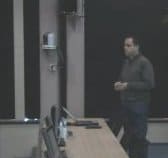By Hamish Johnston
I should have known better than to listen to rumours. But some of the most reliable gossips in the particle-physics blogosphere had being saying to expect news of evidence for a supersymmetry particle – or sparticle – to come from the Large Hadron Collider today.

So, earlier today I donned my headphones and pointed my browser at a talk given by Ximo Poveda of the ATLAS experiment (right), who was tipped to be the bringer of good news. He went through four or five searches for several supersymmetric partners of various quarks and leptons – squarks and sleptons called the stop, stau and sbottom – and each time the conclusion was “we see nothing beyond the Standard Model”.
Supersymmetry (or SUSY) is an attractive route beyond the Standard Model because it offers a solution to the “hierarchy problem” of particle physics, provides a way of unifying the strong and electroweak forces, and even contains a dark-matter particle. Many physicists hope the LHC will confirm SUSY’s central prediction – that for each of the Standard Model particles there exists a heavier sparticle sibling. But so far, nothing beyond the Standard Model has emerged.
Oh, well. On a brighter note, CERN has announced that in 2012 it will be running the LHC at the higher collision energy of 8 TeV, instead of the 7 TeV collisions that took place in 2011. As well as boosting the chances that sparticles will be spotted, the move to a higher energy should also make it clearer whether the Higgs boson has been found with a mass of about 125 GeV – as suggested late last year.
The downside is that higher-energy collisions require greater current flowing through the LHC’s superconducting magnets – and there is a problem with the electrical connectors between magnets. In 2008 the LHC failed spectacularly when one of these connectors overheated; let’s hope that doesn’t happen again.



